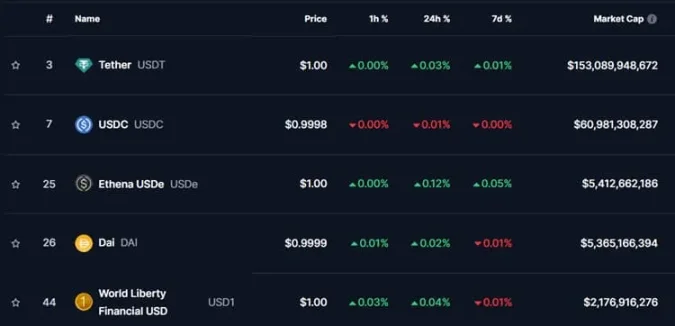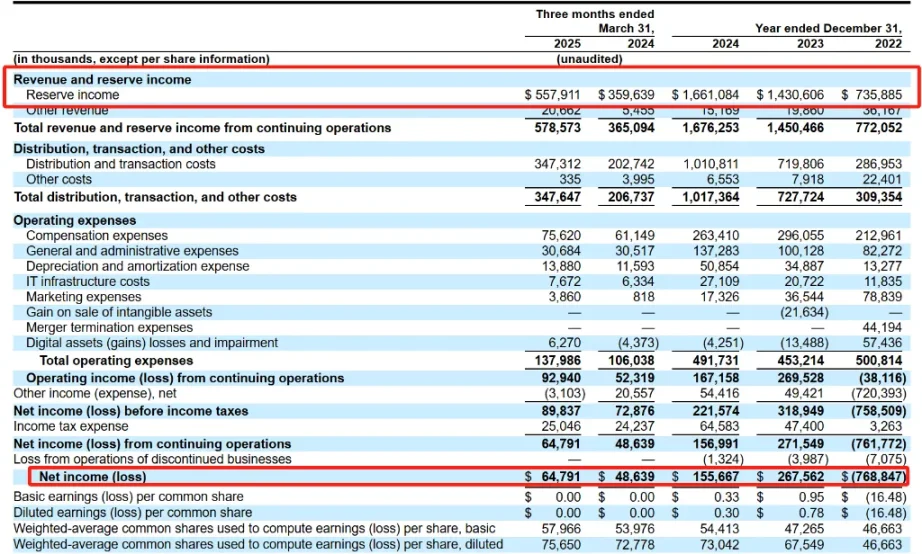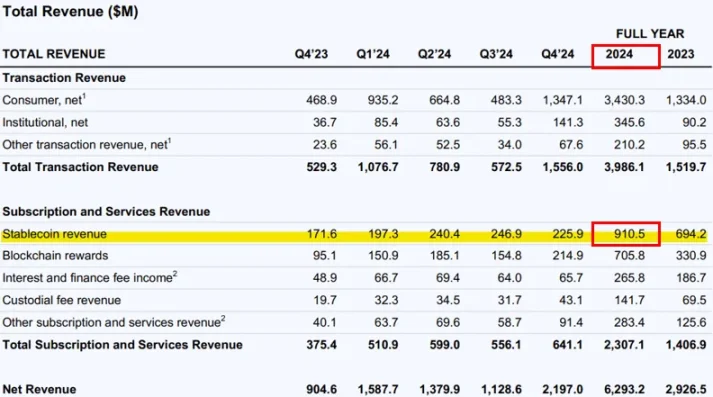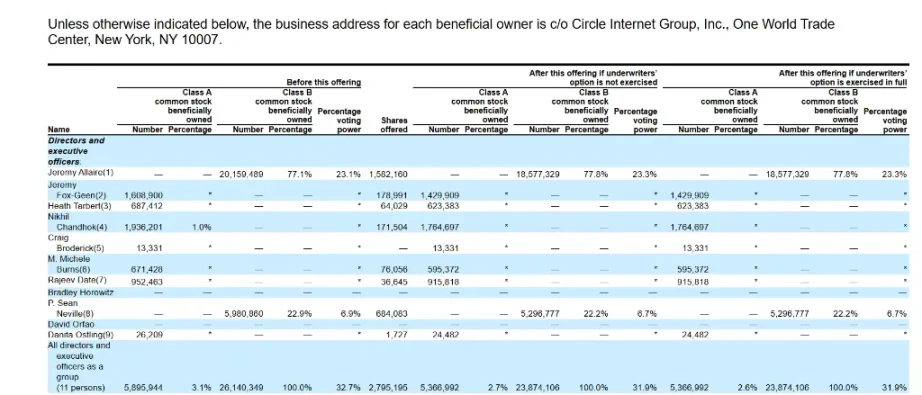Written by: Xu Chao, Wall Street Insights
This Thursday, the cryptocurrency market welcomes the most important IPO of the year.

(Image generated by Doubao AI, prompt: trend and crisis)
Circle Internet Group - the issuer of the $60 billion USDC stablecoin - will be listed on the New York Stock Exchange. The company will issue 32 million Class A shares with a price range of $27-28, expecting to raise up to $896 million, with the stock ticker CRCL. The company will complete pricing on Wednesday night and begin trading the next day.

This IPO has been hotly pursued by Wall Street. Circle's target valuation has been raised from the previous $5.65 billion to $7.2 billion. BlackRock is leading with a 10% stake, and Ark Investment has expressed an investment interest of up to $150 million.
But behind the glamorous appearance of Wall Street giants rushing in, Circle also faces structural challenges.
The seemingly "perfect" money printing machine model
Stablecoins have quietly become the pillar of the cryptocurrency market and are increasingly closely related to traditional finance. In 2024, stablecoin transaction volume reached $27.6 trillion, nearly 8% higher than the total transaction volume of Visa and Mastercard.
Currently, the total market value of stablecoins has reached $248 billion, with Circle's USDC occupying 25% of the market share, second only to Tether's USDT at 61%, with a total market value of $60 billion. Circle's EURC leads in euro-backed stablecoins, with a market value of $224 million.

Circle's advantage lies in its regulatory compliance.
In the United States, USDC positions itself as a compliant bridge between the cryptocurrency ecosystem and traditional finance. In the EU, the implementation of MiCA - and the resulting delisting of non-compliant stablecoins like USDT from major regulated exchanges - paved the way for USDC to become the leading stablecoin in the region.
Circle's business model is simple and tempting: the company issues USDC stablecoins pegged 1:1 to the US dollar, investing the $60 billion deposited by users in short-term US Treasury bonds to earn risk-free returns.
The company mainly invests in US Treasury bonds (85% managed by BlackRock's CircleReserveFund) and cash (10-20% deposited in globally systemically important banks). This model is highly profitable, generating about $1.6 billion in interest income ("reserve income") in 2024, which accounts for 99% of Circle's total revenue.
Coinbase "bloodsucking"
Behind the seemingly "perfect" money printing machine model, Circle's financial data reveals a dual face of growth and pressure: in 2024, Circle's total revenue and reserve income reached $1.676 billion, a year-on-year growth of 16%, steadily rising from $1.450 billion in 2023.
However, net profit dropped from $268 million to $156 million, a decrease of 42%.

Behind the contradictory financial data, "distribution, trading, and other costs" surged, with Circle's profit-sharing agreement with Coinbase being the main influencing factor.

Coinbase and Circle's cooperation began in 2018: the two established the Centre Consortium, creating USDC. In 2023, after the alliance dissolved, Coinbase obtained Circle's equity, and Circle gained full control of the USDC ecosystem.
However, this split did not end the cash flow distribution between the two companies, which still share the interest income from USDC reserves. According to Circle's S-1 filing, there is the following revenue-sharing agreement between Circle and Coinbase:
USDC on Coinbase platform: Coinbase receives 100% of reserve income.
USDC on non-Coinbase platforms: Coinbase and Circle each receive 50% of reserve income.

As of the first quarter of 2025, USDC on the Coinbase platform accounts for about 23% of total circulation. This proportion shows Coinbase's important position in the USDC ecosystem and reflects its role as the primary custody platform.
According to Coinbase's disclosed data, in 2024, Coinbase earned $908 million from USDC-related business, accounting for about 14.5% of its net income.

Coinbase also has the right to decide on Circle's business cooperation partners. If Circle wants to sign a new revenue-sharing or distribution agreement with a third party, it needs Coinbase's approval.
Some analysts believe that the "close" cooperation terms may lay the foundation for Coinbase's potential future acquisition of Circle.
Hidden "fatal" flaws
Besides the high "distribution" costs, Circle's seemingly "money printing machine" business model has serious flaws.
First, Circle's revenue is very dependent on interest rate performance. Calculated at a 4.75% return rate, $60 billion of USDC can generate about $2.85 billion, which is approximately the income Circle can obtain without taking any risks.
But when interest rates drop, problems arise. The cost of maintaining these returns (in terms of risk) will be higher. Taking excessive risks can be very tempting. There is also pressure from competitors who may be willing to sacrifice most of their reserve income to gain market share.
Meanwhile, Circle's performance is closely tied to the highly volatile broader crypto market.
Due to the collapse of Terra and FTX platforms, Circle suffered a loss of $768.8 million in 2022; in 2023, after the bankruptcy of Silicon Valley Bank, a Circle partner, USDC faced selling pressure, directly causing its market value to halve (at the time of signing the Coinbase agreement).
External competitive pressure increases sharply
US dollar-backed ordinary stablecoins have no entry barriers. Providers need to be more creative than competitors to make their stablecoins the industry standard.
ARK believes that by 2030, the scale of stablecoins will increase from the current approximately $250 billion to $1.4 trillion. This may depend on how much "floating income" stablecoin issuers are willing to share as "incentives" to win or seize market share.
As the regulatory environment becomes clearer, Circle may face more intense competition. Tech giants like Amazon and Google might launch their own stablecoins, while banks like Bank of America, Citigroup, and JPMorgan Chase are exploring joint stablecoin issuance.
PayPal has already launched its own stablecoin and plans to return most reserve income to users. This trend of "competing to give benefits" may compress the profit margins of the entire industry.
IPO timing couldn't be better
Despite various internal and external challenges, Circle's IPO timing is "just right"
Supporters believe that stablecoins are becoming de facto digital dollars - especially in an environment where the US is increasingly hostile to central bank digital currencies (CBDC). The potential market for stablecoins covers global remittances, institutional payments, and DeFi integration. The infrastructure and regulatory positioning built by Circle may give it a head start.
As Benjamin Billarant, founder of Balthazar Capital (an asset management firm with extensive investments in crypto-related stocks), commented,
Circle's IPO timing couldn't be better. We have reached a critical turning point for mainstream stablecoin adoption. Once the GENIUS Act passes, it will provide the regulatory transparency needed to unleash its full potential - and Circle, with its compliance-first philosophy, has a unique advantage in leveraging this opportunity.
In fact, the most comprehensive stablecoin bill in the US to date - the bipartisan GENIUS Act - was passed in the Senate on May 21 and is currently under review in the House of Representatives. This is undoubtedly an excellent timing for Circle's IPO.
The $7.2 billion high valuation is also telling a similar "story" (Circle's PE valuation has exceeded credit card giant Visa): USDC is just the beginning of tokenization.
Although Circle currently relies on the demand in the cryptocurrency market, stable coins will sweep the globe as a more smooth and efficient payment method than what is currently offered in the future.
In addition to ordering pizza at home or buying goods from abroad, it will be possible to build new applications and financial products on the same track. As the Trump administration pushed stable coins into the mainstream, this will expand the demand for USDC and generate more fee income.
Is a valuation of $7.2 billion reasonable? The market will ultimately provide the answer. But one thing is certain: whether Circle can transform in time will determine its long-term fate in the process of shifting from "easy" interest-driven revenue to more challenging product-driven income.
Major Shareholders Sell, Wall Street Buys
Interestingly, Circle's existing shareholders are using this IPO to cash out on a large scale.
According to the prospectus information, the shares sold by Circle's existing shareholders account for 60% of the total issuance, far higher than a typical tech IPO.
According to the company's prospectus, Circle CEO Jeremy Allaire will sell 8% of his shares, and several well-known venture capital firms also plan to reduce their holdings by about 10%. Although internal shareholders still retain a large number of shares, such large-scale cash-outs may send complex signals to the market.

In tech company IPOs, it is extremely rare for the issuance from existing shareholders to exceed the company's issuance.
Meta is one of the few exceptions. The social network raised a record $16 billion in its massive IPO in 2012, with 57% of the shares sold by existing shareholders.







